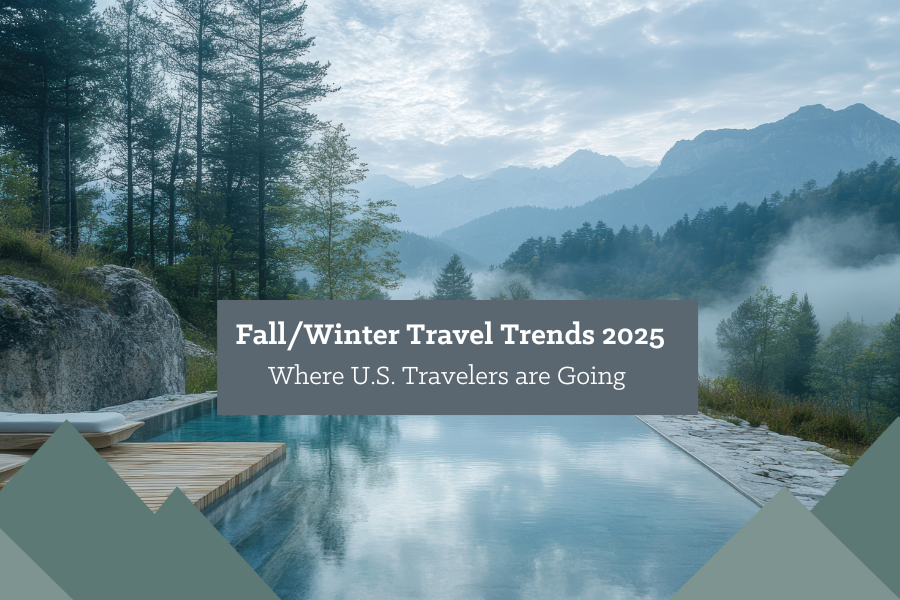Welcome to the May 2025 IGES newsletter. This month, we examine the evolving dynamics of U.S. tourism, focusing on shifting travel behaviors and emerging opportunities for retailers.
Top Travel Trends for Summer 2025
International Inbound Travel Declines
International travel to the U.S. has significantly declined, with airlines like Air France-KLM and Lufthansa reporting reduced bookings due to U.S. trade policies and strict immigration measures. Data from the National Travel and Tourism Office reveals an 11.6% drop in visitor numbers in March, while Tourism Economics forecasts a 15.2% decline in foreign travel to the U.S. in 2025. Especially sharp declines are seen from Germany and Spain, with respective drops of 30% and 25%, while Australian visits fell by 7% year-over-year—the steepest since the COVID-19 pandemic peak.
Domestic Travel Patterns Shift
While international arrivals wane, domestic travel remains robust. A survey by Vacasa indicates that Americans are embracing exploration, with a notable increase in domestic travel plans for summer 2025. However, economic factors such as rising tariffs and inflation are influencing travel choices, leading many to opt for more budget-friendly options like road trips and local destinations.
Merch Magic: Display Trends That Convert
Destination Moodboards: Visual Storytelling That Sells
As travelers seek immersive and emotionally resonant retail experiences, visual storytelling is becoming a powerful merchandising tool. By curating “destination moodboards” in-store — displays that capture the spirit, color palette, and textures of a local landmark, natural feature, or seasonal event — tourism retailers can connect emotionally with shoppers and increase basket size.
Tactical Implementation:
- Thematic Zones: Organize retail space into mini-environments (e.g., “Lakeside Leisure,” “Historic Downtown,” or “Desert Bloom”) that evoke local culture and landscapes. Use natural materials, scent diffusers, and ambient sounds to enhance the atmosphere.
- Local Collabs: Partner with local photographers, illustrators, or cultural historians to add rich storytelling and provenance details.
Hyper-Functional Keepsakes: Practical Meets Personal
Travelers are shifting from tchotchkes to purposeful purchases. Consumers — especially solo travelers and families — now want souvenirs that serve a function while still capturing the spirit of their trip.
Hot Items to Consider:
- Customizable Travel Journals & Scratch Maps: Offer refillable or region-specific editions.
- Locally Sourced Self-Care Kits: Think herbal eye pillows, bath salts, or essential oils sourced from nearby farms or coastlines.
- Weather-Responsive Apparel: Carry gear that fits your region’s climate — UPF-rated shirts in the desert, storm-proof ponchos in coastal towns, or temperature-adaptive hats for mountain destinations.
Customer Connection Corner
Addressing Economic Concerns
As tariffs drive up the price of travel-related goods and services, budget-conscious travelers are changing their behavior—opting for off-peak periods, flexible itineraries, and cost-effective destinations. This shift in consumer sentiment reflects the growing pressure points felt across the travel value chain.
Tactical Implementation:
- Transparent Pricing: Clearly communicate pricing and any additional fees to build trust with customers.
- Flexible Booking Options: Offer flexible booking and cancellation policies to accommodate changing travel plans.
IGES Ideas: Product Spotlight
Homegrown Keepsakes
As domestic travel surges, products that celebrate local identity are in high demand. Consider a collection of regionally themed souvenirs—think handcrafted art, locally produced snacks, or eco-friendly apparel—that capture the essence of a place and appeal to the pride of local residents.
Attraction Action
Innovative Experiences to Attract Visitors
Attractions are adapting to changing visitor demographics by enhancing experiences for domestic tourists. Tailoring exhibits and events to local interests can maintain engagement and attendance. For instance, MSC Cruises has launched the MSC World America, its first cruise ship designed specifically for the U.S. market, marking a major shift from its European roots. Based in Miami, the ship caters to American preferences with a blend of European style and American comfort. New onboard offerings include an Eataly restaurant, fast-casual dining options, a sports bar, and American-inspired attractions like a comedy club and an amusement park-style activity hub called The Harbour.
Stay tuned as we continue to navigate these changes together. We invite you to subscribe for more insights and strategic ideas to keep you ahead in the evolving tourism market.









